Quiz Answer Key and Fun Facts
1. The letter 'A' is for 'Ascension'. According to Luke 24:49-53, Jesus was in Bethany when He ascended to Heaven. Where was Bethany?
2. The letter 'B' is for the word 'Born'. In what city was Jesus born, according to Scripture? (Matthew 2:1 and Luke 2:4)
3. The letter 'C' is for 'Cana'. According to John 2:1-12, Jesus performed His first miracle in Cana. What was the miracle?
4. The letter 'D' is for 'Disciples'. In addition to the Twelve Disciples, Jesus also appointed a team of Seventy Disciples, as per the tenth chapter of Luke in the KJV and the NKJV.
5. The letter 'E' is for 'Emmaus'. It was on the road to Emmaus that Jesus made one of a number of surprise appearances after His crucifixion. According to Luke 24:13-35, Jesus appeared to two men, one of whom is identified. What's the name of the man who is identified? (Luke 24:13-35)
6. The letter 'F' is for 'Faith'. Complete the two missing words from this statement by Jesus in Matthew 17:20 in the NKJV: "If you have faith as small as a __________ you will say to this mountain, 'Move from here to there,' and it will move; and nothing will be impossible for you."
7. The letter 'G' is for 'Greatest'. In two different accounts in the Gospel of Luke, the disciples have a dispute about who will be the greatest. (Luke 9:46-50 and 22:24-30.) In the first account, what does Jesus use as an illustration for someone who wants to be great?
8. The letter 'H' is for 'Healing'. According to the four Gospels, Jesus performed dozens of miracles, many of them pertaining to people being healed. However, there is no way of determining the exact number of people who were healed, regardless of how carefully and thoroughly one reads the New Testament.
9. The letter 'I' is for 'Immanuel'. Christians sometimes refer to Jesus as Immanuel. According to Matthew 1:23, what does Immanuel mean?
10. The letter 'J' is for 'Jesus'. Two of Christ's better-known miracles involve calming a storm on the Sea of Galilee and feeding a multitude with a pittance of food. However, Scripture states He calmed two different storms on the Sea of Galilee and also fed two large gatherings of people on two different occasions.
11. The letter 'K' is for 'Kill.' According to Luke 4:28-30, a hostile multitude was determined to kill Jesus by throwing Him over a cliff. However, He miraculously evaded them after they led Him to the edge of a cliff to throw Him to His death. How did Christ evade them?
12. The letter 'L' is for 'Lazarus'. Scripture tells of Jesus raising Lazarus from the dead at Bethany. According to Scripture, how many days had Lazarus been dead when Jesus brought him back to life?
13. The letter 'M' is for 'Mary Magdalene'. According to John 20:11-18, the first person to see Jesus after the resurrection was Mary Magdalene. Scripture states that when the two encountered each other, they had an extremely lengthy embrace.
14. The letter 'N' is for 'Nicodemus', a Pharisee who was told by Jesus "unless one is born again, he cannot he see the kingdom of God." As per John 3:2, what time of day did Nicodemus meet with Jesus?
15. The letter 'O' is for 'Old'. According to Luke 3:23, how old was Jesus when He started His ministry?
16. The letter 'P' is for 'Parables'. Jesus is known for speaking in parables, in fact there are thirty-nine of them in the Gospels. According to many scholars, what was the advantage of Christ speaking in parables?
17. The letter 'Q' is for 'Quiet.' According to Scripture, when Jesus performed a miraculous healing, He often told the person to remain quiet and not tell anyone.
18. The letter 'R' is for 'Resurrection'. Scripture tells of Jesus appearing to the disciples as well as others after His resurrection. In fact, according to 1 Corinthians 15:6, how many people did Christ appear to after His resurrection?
19. The letter 'S' for 'Siblings'. According to Matthew 13:55, how many brothers did Jesus have? (NKJV)
20. The letter 'T' is for 'Tears'. Scripture tells of Jesus weeping amongst people who had gathered at the home of a person who had died. What was the name of the deceased? (John 11:1-44)
21. The letter 'U' is for 'Unbelief'. According to Matthew 13:58, Jesus did not do "many mighty works" in a particular area due to the unbelief of the people. What was the name of the community that Jesus opted to pass by and perform miracles in other areas of Israel?
22. The letter 'V' is for 'Vipers'. As per Matthew 12:34, who did Jesus call "a brood of vipers"? (Similar words were echoed earlier by John the Baptist in Matthew 3:7)
23. The letter 'W' is for 'Way' as in Christ's famous statement "I am the way, the truth and the life. No one comes to the Father except through Me." (John 14:6) How many so-called 'I am Statements' did Jesus make in the Gospel of John?
24. The letter 'X' and 'Y' are for 'Young'. What was the age of the young Jesus when His family found Him in Jerusalem participating in an in-depth discussion with rabbis? (Luke 2:42)
25. The letter 'Z' is for 'Zacchaeus'. When Jesus saw Zacchaeus up a sycamore tree in Jericho, what's the first thing He said to him, as per the NKJV? (Luke 19:1-9)
Source: Author
Cowrofl
This quiz was reviewed by FunTrivia editor
agony before going online.
Any errors found in FunTrivia content are routinely corrected through our feedback system.

